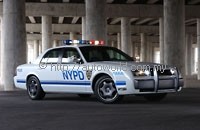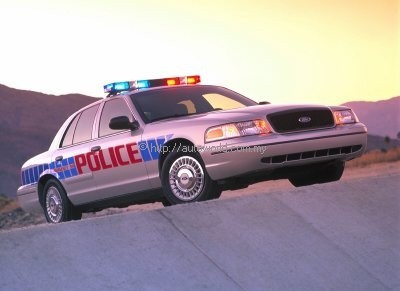For Future NYPD Blue Movies
You see them in the movies… those big American police cars which scream after the bad guys, slide round corners and also crash spectacularly. They are not just Hollywood creations but are really what American police cars look like, as anyone who has been to that country can confirm.
The most widely used model is the Ford Crown Victoria Police Interceptor and as with models sold to the public, police cars also get upgrades from time to time to improve their performance and dynamics.
This year, Ford is also showing Interceptor concept which is based on the latest Ford Police Interceptor. “The Interceptor concept is a true professional law enforcement tool for the future,” said Chris Theodore, vice president, Ford North America Product Development. “It’s designed to look intimidating and perform its duties with unparalleled skill and unwavering bravery.”
One look in the rearview mirror will leave would-be law-breakers with a feeling of dread as the Interceptor concept closes in on them. The front end features a one-of-a-kind push/pursuit beam that extends beyond the normal bumper of a police car.
The structural beam is constructed of a reinforced polymer. Mounted to the front beam is a high-strength stainless steel and cast aluminium pushbar used for assisting stranded vehicles.
When the bad guys feel confidence in fleeing and pose a risk to public safety, the Interceptor concept’s push/pursuit beam can become an offensive tool in the skilled hands of a well-trained officer. With a properly executed push in the corner of the vehicle, the beam can be used to force a fleeing suspect’s vehicle into a spin. This technique is used to disorient a fleeing suspect and disable their vehicle, thus avoiding a risky high-speed chase scenario.
Because the beam extends well beyond the standard bumper and has molded-in colour, it reduces the need for costly body. Like the push/pursuit beam on the front end, the rear bumper features a structural ABS polymer extension.
The Interceptor concept also has extra-illuminating high-intensity discharge (HID) headlamps flanked by halogen strobe lights. Mounted to the side are innovative search mirrors, with integrated front-facing halogen searchlights combined with the side view mirrors. The searchlights swivel up, down and from side-to-side freely and are operated remotely from within the cabin. The search mirrors provide officers the full functionality of traditional A-pillar mounted searchlights without the need to bore holes in the car’s A-pillar. The results include a more ergonomic control mechanism inside, better quality and fit, and improved vehicle aerodynamics.
Fitted atop the Interceptor concept is an Edge lightbar complete with flashing halogen and strobe lights. The bar features sun, snow and fog modes for use in extreme weather conditions and is topped off with a blasting radio siren. The rear deck and taillamps are sequentially integrated to strobe when the vehicle is parked with the light array activated.
The inside of a police car is a place few civilians ever want to find themselves invited to sit. But it’s where thousands of officers put in a full-day’s work – their ‘office on wheels’. Because so much of their day can be spent in their cruiser, police officers will want a comfortable car seat.
The Interceptor concept considers the comfort of its cop cargo with specially-designed front bucket seats. The seats have a narrow “seat-bite” to accommodate officers’ bulky belts and holsters. They are reinforced with hard plastic backs to prevent prisoners from kicking through the seat or piercing the seat with a weapon from the rear. A taller headrest provides greater support behind the head with a double lock inhibiting the wrong person from removing it and using it as a weapon.
Installed in the centre of the control panel is a boot-release button, giving both the driver and the front passenger quick and easy access to equipment located in the boot (usually some rather big and loud machine guns!). The vehicle’s unique wiring provides a power point below the cupholders, a police-unique powered distribution box in the passenger compartment and an optional power unit in the trunk..
Under the bonnet is the heart of the Interceptor concept – a modular 4.6-litre, 32-valve V8 engine which produces 221 kW/300 bhp and 407 Nm of torque.
“The modular 4.6 is basically the same engine we use in today’s Crown Victoria, Mustang GT and Police Interceptor,” said Theodore. “But the modularity of these engines allowed us to add performance enhancements to match the personality of this extreme law enforcement machine.”
One of the most important benefits of the V8 for police work is the exceptional launch characteristic it provides at the low end (of course, it also performs well at high speeds). However, like personal cars, most police cruisers have speed-limiting electronic governors installed to ensure safety. The V8 in the Interceptor concept allows it to go from a standstill behind a billboard to the bumper of a speeder in a matter of seconds – so don’t try to outrun one if you have exceeded the speed limit!
The Interceptor concept is designed to test new ideas for a new age of law enforcement. The concept is being used to showcase various new technologies to police agencies through 2002 and 2003. Operating as a showpiece and a technology test-bed, the Interceptor concept is outfitted with Delphi’s Accident Data Recorder 2 (ADR2) system. The innovative ADR2 was developed by Delphi Automotive Systems, and was recently selected by Ford Racing Technology and Championship Auto Racing Teams (CART) for use by all racing teams competing in the international CART FedEx Championship Series.
For 2002, the ADR2 is outfitted with a blue cover and works with expanded capabilities to constantly monitor and record vehicle data during a race. Ford Racing Technology engineers believe this “Blue Box” could someday make the leap from racetrack to real world and positively influence the ongoing effort to understand better the dynamics involved in everyday vehicle collisions.
In the event the Interceptor concept is involved in a collision while on patrol, the Blue Box records crash data in addition to speed, throttle, and steering angle. The Blue Box is crash-hardened to ensure the data can be retrieved for investigation and used to study ways to increase safety in future vehicles.
“We think, in the right applications, this technology has some real-world value for police work,” says Theodore. “Such data can help individual agencies and law enforcement in general to understand better what’s involved during the vehicle’s service.”
The Blue Box technology supplements visual data that can be retrieved through the use of in-car cameras. Because of the nature of police work, the cameras are not always reliable in providing important information.
The Interceptor concept gives officers an edge when inhibited by the dark of night with the NightEye night-vision technology. NightEye, a low-light camera technology developed by Ford Research Laboratories and SenTech Inc., might help cops of the future to catch crooks who could have escaped in the darkness.
Attached to the light bar atop the vehicle, NightEye CCD cameras require a very low amount of light to operate, enabling officers to improve their vision at night and in all areas around the stopped vehicle. The cameras can be set up to record and automatically displays the view on to a standard police laptop.
The Interceptor concept responds quickly to the call for backup with the use of interceptor-to-interceptor (I2I) communication technology. This technology enables officers to communicate with each other without using a central dispatching infrastructure, providing each Interceptor with the ability to collectively participate in tactical manoeuvres within a range of 500 to 3000 metres.
This communication technology is combined with voice-recognition from Fonix Corporation so that the officer can speak to his vehicle without taking his hands off the steering wheel. Intelligent software listens, understands and acts on the situation by wirelessly sharing emergency information, interceptor location, speed, and heading. Using this same technology, officers can chat back and forth with voice-activated features.
If other Interceptors are not available, the I2I smart system by Nexiq Corporation uses a cellular option and contacts the dispatch centre with a call for assistance. Dispatchers can check a Web site to see where the vehicle is, its speed, and based on vehicle data, it can report the type of vehicle and emergency status. Interceptor-to-Interceptor communication represents advancement in public safety for law enforcement, fire and rescue by further enhancing emergency response time and cooperative manoeuvres for law enforcement and homeland security.
Many of these technologies have been described in an article on safety technologies being developed by Ford which we published in October 2000. The link below will take you to that article.





























